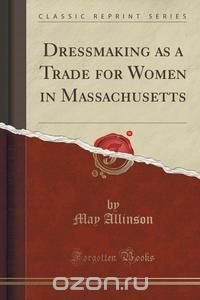Excerpt from Dressmaking as a Trade for Women in Massachusetts
The occupation of dressmaker ranked third in the United States in 1900 in the number of women employed, 338,144 women 16 years of age and over being engaged in it. Only two occupations - that of servant and waitress and that of agricultural laborer - surpassed it in the number of women employed, but in none did women form a larger proportion of the total employees. Because of the numbers the trade employs, because it is woman"s traditional occupation, and because it provides opportunities for development, training for the dressmaking trade has held a large and a logical place in the curriculum of vocational schools for girls. The growth of the movement for industrial education and for vocational guidance has called for a thorough knowledge of the various industries. Especially is this important in the case of those trades which have been recognized as in some degree desirable, and for which the trade schools have attempted to prepare young workers. Almost two-thirds (62 per cent) of the girls who went out from the three Massachusetts trade schools in 1914 had been trained for the dressmaking trade.
Dressmaking is a difficult trade subject for the casual and superficial observer to grasp, because of the variety of types of shops and methods of production which it presents. Dressmakers who go out by the day, small shops, large shops, factories of various types, give the superficial impression that every shop is different. Primitive and highly developed systems exist side by side, yet careful study shows that all may be classified within some six groups, each having a characteristic method of production. The student of census figures may be convinced that custom dressmaking is a declining trade and question if educators are justified in training young workers for this occupation.
About the Publisher
Forgotten Books publishes hundreds of thousands of rare and classic books. Find more at www.forgottenbooks.com
This book is a reproduction of an important historical work. Forgotten Books uses state-of-the-art technology to digitally reconstruct the work, preserving the original format whilst repairing imperfections present in the aged copy. In rare cases, an imperfection in the original, such as a blemish or missing page, may be replicated in our edition. We do, however, repair the vast majority of imperfections successfully; any imperfections that remain are intentionally left to preserve the state of such historical works. Это и многое другое вы найдете в книге Dressmaking as a Trade for Women in Massachusetts (Classic Reprint) (May Allinson)
